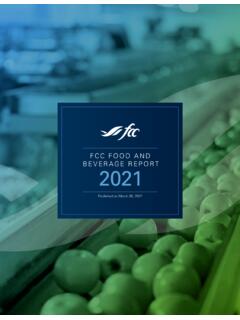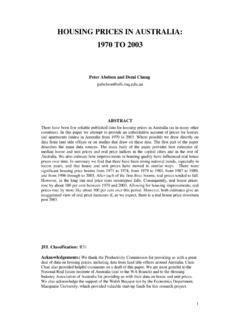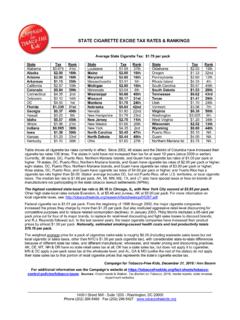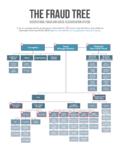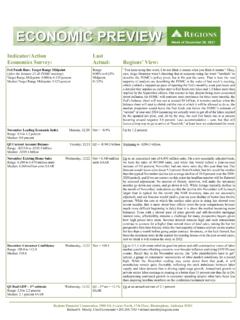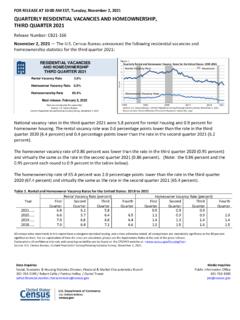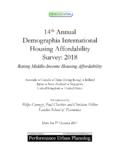Transcription of FCC Farmland Values Report 2020
1 This Report covers the period from January 1 to December 31, 2020 Published on March 15, 2021 FCC Farmland Values REPORT20202 Introduction3 Methodology4 National trend5 Provincial comparison6 British Columbia9 Alberta11 Saskatchewan13 Manitoba15 Ontario17 Quebec19 New Brunswick20 Nova Scotia21 Prince Edward Island22 Newfoundland and Labrador23 ContactContents2020 FCC Farmland Values ReportFarm Credit Canada (FCC) understands the value of having access to solid market information when making management decisions.
2 That s why we compile and release the Farmland Values Report . It tracks and highlights average changes in Farmland Values regionally, provincially and nationally and provides a value indicator that allows for a region- to-region price-per-acre , of course, is only one factor to be considered when purchasing land. Other factors include the location, timing of an expansion, and the individual s financial situation and personal goals. Producers should have and maintain a risk management plan that considers possible economic changes to ensure budget flexibility if commodity prices, yields or interest rates shift.
3 Market conditions can change rapidly, which can impact land Report presents the evolution of land prices from January 1 to December 31, 2020. It provides one source of information to help producers manage risk and make informed business FCC Farmland Values REPORTM ethodologyFCC established a system based on benchmark farm properties to monitor variations in cultivated land Values across Canada. These parcels are representative of each area of the country. FCC appraisers estimate market value using recent comparable land sales.
4 These sales must be arms-length transactions. Once sales are selected, they are reviewed, analyzed and adjusted to the benchmark farm analysis is supplemented by trends in overall Farmland sales data collected across each region. The reference value published by FCC is derived from the average value of our benchmark properties and the average sales price in each value range published represents 90% of sales data collected by FCC in the past year in these areas. The range excludes 5% of the highest and lowest sales to remove the outlier Values and keep the range reflective of typical sales prices.
5 This data is provided to help understand the variability in the value of Farmland in each continuously reviews benchmark properties to ensure they are representative of the general region. For this year s Report , changes were made in the location and land types of benchmarks, which impacts the dollar value per acre provided in each region. In the past, rates included cultivated and irrigated land, as well as land used for orchards and blueberry production. This year s Report now only considers cultivated land and offers a separate analysis for irrigated * There was an insufficient number of publicly reported transactions to accurately assess Farmland Values in Newfoundland and Change in Farmland 3 % 2 % *N/A* % change in Farmland 2.
6 1% 9% trendThe average value of Canadian Farmland increased in 2020, slightly more than the increase reported in Report acknowledges 2020 was a challenging year that will go down in history for the economic disruptions caused by the COVID-19 pandemic. The consequences, however, were not as prominent in the real estate and agriculture land markets, compared to most other parts of the Canadian economy. Crop sectors have done well, and demand for Farmland across Canada remained the first six months of 2020, there was a noticeable decrease in the number of sales, mostly in April and May.
7 However, the total number of sales for the entire year was like those of the past few years. Despite a challenging global economic environment, commodity prices increased considerably in the last half of 2020 for many crops, and interest rates have reached historic important supply chain disruptions caused by the pandemic, demand for food remains strong. The agriculture land market has generally been stable. However, it s important to remember that reported numbers are based on averages, and there are often important differences between regions within each highest provincial increases in 2020 were recorded in British Columbia and Quebec, with averages of 8% and , respectively.
8 Alberta followed with an increase of 6% and Saskatchewan mirrored the national average increase of Ontario and Manitoba both reported increases that were lower than the national average at and , Maritime provinces saw the smallest increases in Farmland Values for 2020. There was an average increase of for Prince Edward Island, for Nova Scotia and for New the fifth consecutive year, there was an insufficient number of publicly reported sales in Newfoundland and Labrador to fully assess Farmland FCC Farmland Values REPORT2020 FCC Farmland Values REPORT5 Provincial comparison of Farmland Values Annual % change in Farmland Values January 1 to December 31.
9 2020*There was an insufficient number of publicly reported transactions in 2020 to accurately assess Farmland Values in Newfoundland and . N 3% /A*2020 FCC Farmland Values REPORTB ritish ColumbiaBritish Columbia saw an average increase in Farmland Values of 8%, the highest provincial average increase in Canada for 2020. It was also the largest average increase in the province since 2016 when it reported a jump of As usual, regional market activity varied throughout the region recorded the most significant upward trend in the province with, an average increase of in 2020.
10 Buyers tended to be from outside the Kootenay region and larger urban centres, which created sudden and potentially short-term competition for land. These buyers were drawn to what they considered affordable land and the opportunity to escape the more populated interior regions of Thompson-Nicola and Cariboo-Chilcotin maintained strong land markets. Cariboo-Chilcotin had an average increase of , primarily due to limited availability of good quality land. This resulted in minimal sales and strong prices in the region.

